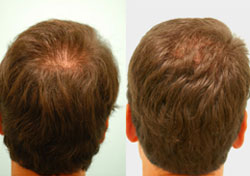Men lose about 50 to 100 hairs every single day, and while majority of them are able to regenerate lost hair without any intervention, there are those who are predisposed to permanent hair loss, which means that their own system cannot replace the hairs they’ve lost. In the United States, it has been found that there are 40 million men suffering from hair loss and this is why it has become a major issue. A large number of men experiencing this problem are seeking out possible ways to treat the problem, and if you are one of them, then you can find the answers you are looking for, here.

Who’s at Risk of Hair Loss in Men?
Numerous men and women are at risk of hair loss. For the male population, it’s been said that about two-thirds of them will sooner or later be affected by a widespread condition called male pattern baldness, especially Caucasians and African-Americans. Moreover, those who have male pattern baldness in their family are also at risk of developing the said condition since it is known to be a genetic condition as well. Essentially, hair loss in men is caused by the hormone dihydrotestosterone or DHT, which have negative effects on genetically vulnerable hair follicles found on the scalp. Its impact is mostly limited to the top, front, and crown areas.
Male Hair Loss Treatment Options
The prevalence of hair loss in men has given rise to a wide array of treatment options. As of today, here are the most popular choices that you can consider:
- Minoxidil: This topical cream comes in 2% and 5% variants, and if used consistently for a period of 3 to 6 months, it’s been shown to give nice results on about a third of the people who have used it.
- Propecia: This treatment option contains 5-alpha-reductase inhibitors, which could inhibit the testosterone from turning into DHT. However, because of the side effects (impotence, among others), it can only be given through private prescription.
- Hormone therapy: The use of hormonal drugs such as an anti-androgen therapy can block the function of DHT however this should only be given with the supervision of a hormone specialist.
- Male hair transplant: This treatment option is considered to be the only permanent cure to hair loss in men. It is an expensive procedure but it can nevertheless put an end to your misery through the regrowth of hair on your bald spots.
What You Should Know About Male Hair Transplant
Hair transplantation is different for men and women. This is because hair loss in men follows a certain pattern while that of women occurs all over the head. Men suffering from hair loss usually experience receding hairlines and thinning around the top area of the scalp. There are two options for male hair transplant methods that you can consider and these are the follicular unit transplantation, also known as the Strip Method, and the follicular unit extraction. The former is less expensive but may leave a scar on your head while the FUE is gentler, slower, and can produce minimal or no scar, but it is the more expensive choice.
